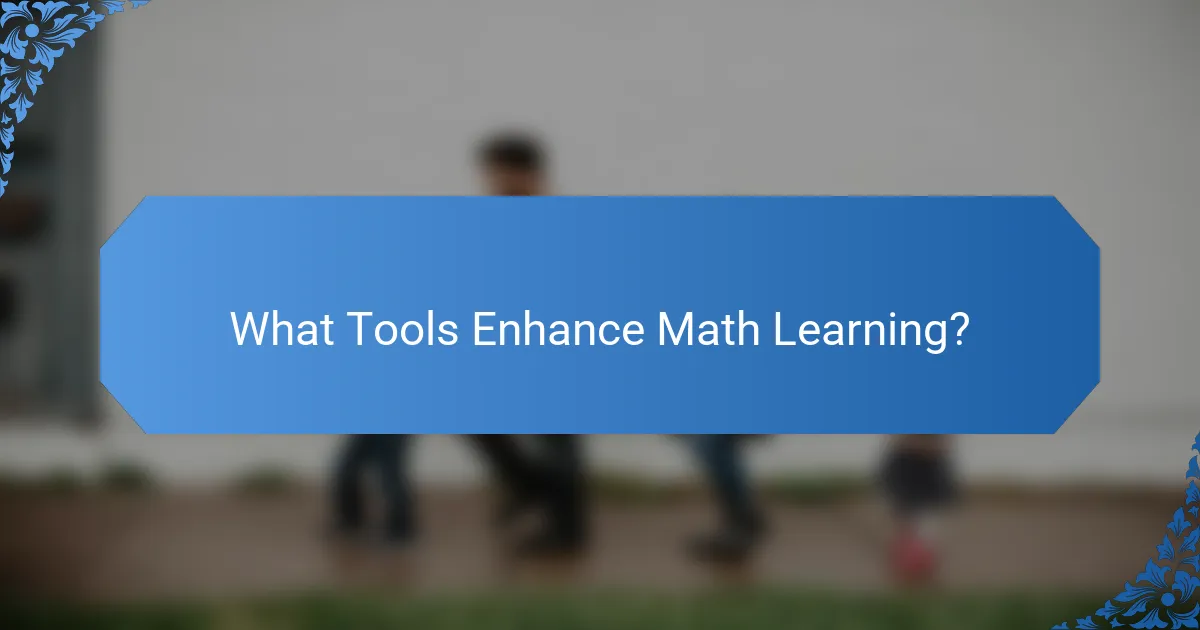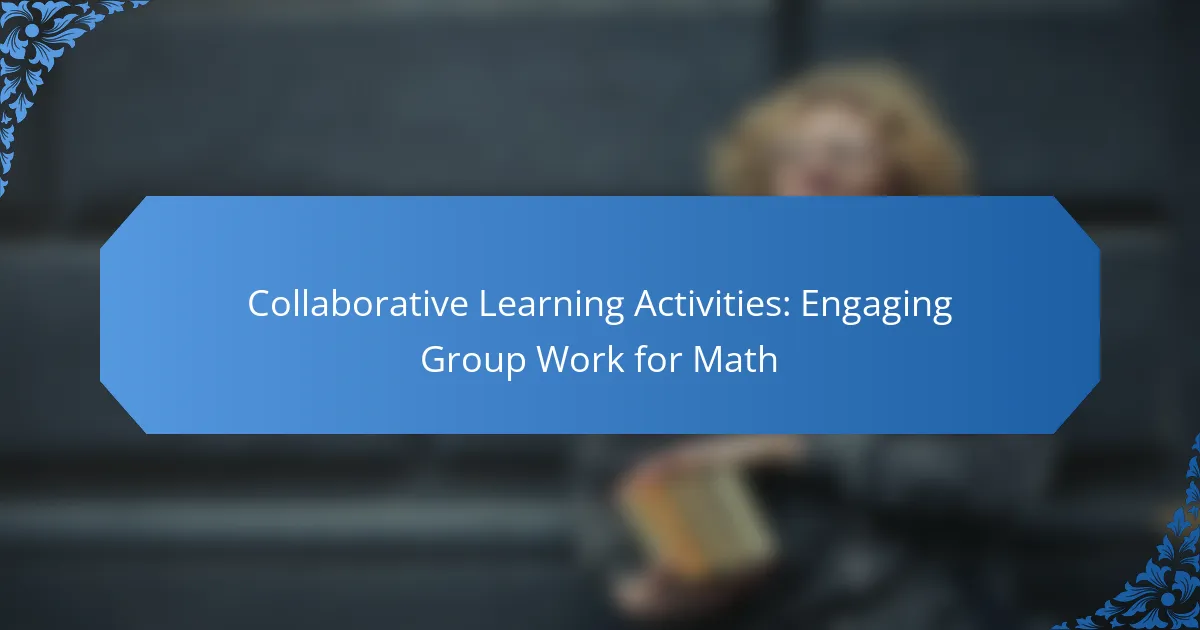Mastering math can be a fun and rewarding experience for elementary students when effective study techniques are employed. By incorporating visual aids, interactive games, and collaborative learning, children can enhance their understanding and retention of mathematical concepts. Additionally, creating a structured and supportive environment at home can further boost their confidence and enjoyment in learning math.

What Are Effective Math Study Techniques for Elementary Students?
Effective math study techniques for elementary students include a variety of methods that cater to different learning styles. Utilizing visual aids, interactive games, and collaborative study sessions can significantly enhance understanding and retention of mathematical concepts.
Visual Learning Strategies
Visual learning strategies involve using images, diagrams, and charts to help students grasp mathematical concepts. For instance, using number lines or pie charts can make abstract ideas more concrete and relatable. Parents and teachers can create colorful posters or flashcards to reinforce key concepts.
Incorporating visual tools like manipulatives, such as blocks or counters, allows students to physically engage with numbers, making learning more interactive. This hands-on approach can be particularly beneficial for younger learners who may struggle with traditional methods.
Interactive Games
Interactive games are an engaging way to reinforce math skills while making learning fun. Board games, card games, and online math games can help students practice addition, subtraction, and other fundamental skills in a playful environment. Look for games that are age-appropriate and align with the curriculum.
Incorporating competition, such as timed challenges or team-based activities, can motivate students to improve their skills. However, it’s essential to ensure that the focus remains on learning rather than just winning.
Practice Worksheets
Practice worksheets provide structured opportunities for students to apply what they have learned. These worksheets can include a variety of problems, from simple calculations to word problems that require critical thinking. Regular practice helps reinforce concepts and build confidence.
When selecting worksheets, consider varying the difficulty levels to match the student’s proficiency. It’s beneficial to include a mix of problem types to keep students engaged and challenged.
Group Study Sessions
Group study sessions encourage collaboration and peer learning among students. Working in small groups allows students to explain concepts to one another, which can deepen their understanding. It’s important to create a supportive environment where all students feel comfortable sharing their thoughts.
To maximize effectiveness, set clear goals for each session, such as focusing on specific topics or solving particular types of problems. This structure can help keep the group focused and productive.
Online Math Platforms
Online math platforms offer a wealth of resources, including interactive lessons, practice problems, and progress tracking. Many platforms cater to different skill levels and can adapt to a student’s pace, making them a flexible option for supplemental learning. Examples include Khan Academy and IXL.
When using online platforms, it’s essential to monitor progress and ensure that students are engaging with the material effectively. Encourage students to set goals for their online practice to maintain motivation and accountability.

How Can Parents Support Math Learning?
Parents can significantly enhance their children’s math learning by creating a structured environment, fostering a positive mindset, and providing necessary resources. These strategies help build confidence and competence in math skills, making learning more effective and enjoyable.
Creating a Study Schedule
Establishing a study schedule helps children develop a routine that prioritizes math practice. Aim for short, focused sessions of about 20-30 minutes, several times a week, rather than long, infrequent study periods. Consistency is key, so try to set the same days and times each week.
Incorporate breaks to keep the study sessions engaging. For example, after every 20 minutes of math practice, allow a 5-minute break for stretching or a quick snack. This approach helps maintain focus and reduces frustration.
Encouraging a Positive Attitude
Fostering a positive attitude towards math can greatly influence a child’s willingness to learn. Praise effort rather than just results, emphasizing that mistakes are part of the learning process. This helps children view challenges as opportunities for growth.
Use positive language and share stories of how persistence leads to success in math. For instance, discuss famous mathematicians who overcame difficulties, reinforcing the idea that perseverance is essential in mastering math concepts.
Providing Resources
Access to diverse resources can enhance math learning. Consider using workbooks, online games, and educational apps that align with your child’s grade level and learning style. Many free resources are available, such as Khan Academy or local library programs.
Additionally, encourage hands-on activities that incorporate math into everyday life, such as cooking or shopping. These practical applications help children understand the relevance of math in real-world situations, making learning more relatable and enjoyable.

What Tools Enhance Math Learning?
Effective tools for enhancing math learning include interactive platforms that engage students and provide personalized feedback. These resources can help elementary students grasp mathematical concepts through practice, games, and tailored lessons.
Khan Academy
Khan Academy offers a comprehensive online platform with a wide range of math resources suitable for elementary students. It features instructional videos, practice exercises, and progress tracking, allowing students to learn at their own pace.
Students can explore topics from basic addition to more complex concepts like fractions and geometry. The platform’s personalized learning dashboard helps identify strengths and areas for improvement, making it easier for parents and teachers to support learning.
Prodigy Math
Prodigy Math is a game-based learning platform that makes math fun for elementary students. Through an engaging fantasy game, students solve math problems to progress, which keeps them motivated and interested in learning.
The platform adapts to each student’s skill level, offering questions that align with their curriculum. Prodigy also provides teachers with valuable insights into student performance, enabling targeted instruction and support.
Mathletics
Mathletics combines interactive activities with a structured curriculum to enhance math skills for elementary students. It offers a variety of engaging games and challenges that cater to different learning styles.
With features like real-time feedback and rewards for achievements, Mathletics encourages students to practice regularly. The platform aligns with educational standards, making it a reliable resource for teachers and parents looking to reinforce classroom learning.

What Are the Benefits of Math Study Techniques?
Math study techniques provide essential advantages for elementary students, enhancing their understanding and application of mathematical concepts. These methods foster skills that not only improve academic performance but also build a solid foundation for future learning.
Improved Problem-Solving Skills
Effective math study techniques encourage students to approach problems systematically, breaking them down into manageable parts. This structured approach helps students develop critical thinking skills, enabling them to tackle complex problems with confidence.
For instance, using visual aids like diagrams or manipulatives can help students visualize problems, making it easier to find solutions. Encouraging students to explain their thought processes can further enhance their problem-solving abilities.
Increased Confidence
When students employ proven math study techniques, they often experience a boost in confidence. Mastering concepts through practice and repetition allows them to feel more capable in their abilities, reducing anxiety related to math.
Simple strategies, such as practicing with flashcards or engaging in group study sessions, can reinforce their skills and provide positive reinforcement. Celebrating small successes can also contribute to a more confident mindset.
Better Academic Performance
Utilizing effective math study techniques can lead to improved academic performance in mathematics. Students who regularly practice these methods tend to achieve higher grades and demonstrate a better understanding of key concepts.
For example, regular quizzes and self-assessments can help identify areas needing improvement, allowing for targeted practice. Consistent study habits, such as setting aside specific times for math practice, can also enhance retention and understanding of material.

What Criteria Should Be Considered When Choosing Techniques?
When selecting math study techniques for elementary students, it’s crucial to consider factors like learning style compatibility and age appropriateness. These criteria ensure that the methods are effective and engaging for young learners.
Learning Style Compatibility
Understanding a child’s learning style can significantly enhance their math study experience. Some students may learn best through visual aids, while others might prefer hands-on activities or auditory instructions. Tailoring techniques to fit these styles can lead to better retention and understanding.
For instance, visual learners might benefit from using colorful charts and diagrams, whereas kinesthetic learners could engage more effectively with physical manipulatives like blocks or counters. Assessing a child’s preferred learning style can guide parents and educators in choosing the most suitable techniques.
Age Appropriateness
Age appropriateness is essential when selecting math study techniques, as children develop cognitive skills at different rates. Techniques that work for older students may not be suitable for younger ones. For elementary students, methods should be simple, engaging, and aligned with their developmental stage.
For example, using games and interactive activities can make learning fun and accessible for younger children. As they grow, introducing more complex problem-solving techniques can help them build on their foundational skills. Always consider the child’s age and maturity level to ensure the techniques are effective and enjoyable.



